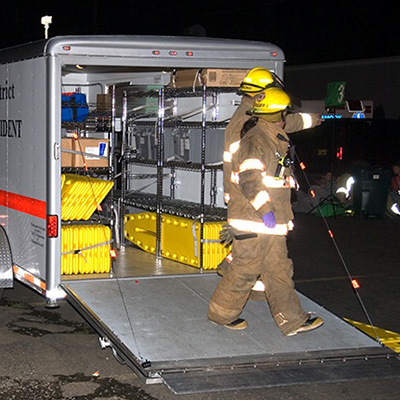Proper emergency planning is a matter of life or death during a disaster response. When the right emergency services are in place, the whole community is safer. Emergency response units are a crucial component of emergency management — as long as they are properly prepped for any emergency situation.
What Is an Emergency Response Unit?
Emergency Response Unit (ERU) team members consist of local government and police departments, first responders, and emergency health care providers ready to be deployed in the event of an emergency situation – they must be ready at a moment’s notice to provide immediate services in critical incidents.
These team members and modules of equipment are designed to operate remotely with little to no resources from the local area. They work with search and rescue teams to find victims who need help and they initiate triage so vital healthcare can be given to those in critical condition.
Community Emergency Response Teams
Community Emergency Response Teams (CERT) educate volunteers on the appropriate disaster preparedness for local issues. CERT volunteers who help deploy Emergency Response Units understand the problems associated with the local environment so that they can provide better care.
Types of Emergency Situations
Disaster preparedness has to take a wide range of potential emergency situations into consideration. Emergency situations include natural disasters, hazardous materials, fire safety, violent attacks, public safety, and public health emergencies.
Each type of emergency situation requires different care. Emergency response for a fire safety incident must include burn care. Natural disasters most likely require search and rescue, while violent attacks and public safety incidents also involve law enforcement. Public health emergencies, such as the COVID-19 pandemic, also require certain emergency response units to be deployed long-term.
Mass Casualty vs. Mass Fatality Events
Major emergency situations are classified as either mass casualty or mass fatality events. Mass casualties are defined as emergency situations that have a higher number of casualties than local services can attend to.
Similarly, mass fatality events occur when the number of fatalities overwhelms local emergency operations. A mass fatality may also qualify as a mass casualty, but not all mass casualty events are also mass fatalities. When one of these critical incidents occurs, deployment of an Emergency Response Unit is crucial in providing life-saving and life-sustaining treatments.
Essential Supplies for Emergency Preparedness
Emergency response activities have four major goals: triage, emergency health care, stabilization, and transportation. Emergency operations must have the personnel and supplies needed to provide these essential emergency services.
Personal Protective Equipment (PPE)
First and foremost, you must protect your first responders while they provide health care to survivors of critical incidents. Personal protective equipment (PPE) protects team members in the field as they tend to the injured. PPE includes a variety of supplies and depends on the type of emergency situation. Incidents with hazardous materials and biohazards can require care providers to wear full safety suits to protect themselves. Face masks and rubber gloves are the most common PPE for any incident.
Triage Supplies
Triage tags allow first responders to provide proper emergency services. First responders use triage tags to quickly identify and prioritize high-risk casualties. The first step in emergency medical operations is to identify the casualties who need the most immediate care. Triage tags allow health care providers to see who has already been evaluated and their status.
These tags clearly identify whether the victim requires immediate care or not. They may also include pertinent information like the patient’s pulse, respirations, mental status, responsiveness, mobility, and if they are a minor or not. Emergency management also includes family reunification if minors are not accompanied by their guardians.
First Aid Kits
No emergency response unit is prepared without fully equipped first aid kits. Proper first aid kits must include basic first aid supplies, such as bandaids, gauze, burn care dressings, nitrile gloves, trauma shears, eye wash, splints, and more.
Emergency Response Trailers
Emergency response trailers are crucial in providing life-saving care in mass casualty or emergency situations and should be a priority in your disaster preparedness plans.
These trailers can transport all the equipment and supplies needed for emergency operations. They are a crucial part of emergency management because they provide first responders with all the equipment needed to provide care in a very organized manner.
Command Vests
Command vests have two main functions: provide visibility for your team members and quickly show the chain of command. They are outlined in safety yellow so first responders can be easily spotted while other colors identify their role in emergency management.
For example, the Deluxe Disaster Kit by Disaster Management Systems includes vests for 13 positions of emergency operations: incident commander, triage unit leader, treatment unit leader, minor treatment manager, delayed treatment manager, immediate treatment manager, morgue manager, medical communications coordinator, ground ambulance coordinator, helispot manager, medical group supervisor, patient transportation unit leader, and patient loading coordinator.
Mass Oxygen Distribution Systems
Most mass casualty and emergency situations leave patients requiring supplemental oxygen. In these critical incidents, many people need oxygen at the same time. Mass oxygen distribution systems allow care providers to supplement oxygen to multiple patients at once with different oxygen flow amounts for each. These oxygen systems often work with their own generators to not require external power for operation.
Stretchers
Stretchers and beds are an important aspect of managing a medical surge in an emergency situation. Critical incidents see casualties of varying severity. Some may be able to walk and sit on their own, while others may be unconscious or unable to walk. Having cots and stretchers is important in providing health care to victims of all severity.
In addition to stretchers, some patients may require splints or backboards if there is a suspected neck or spinal injury. If a neck or spinal injury exists, improper movement can paralyze the patient or cause a fatality.
Hazardous Materials Management
Hazardous materials are evident during any type of emergency situation. First responders must be aware of the biohazard involved in providing health care. Any type of bodily fluid is considered a biohazard, so protection and waste management must be included in your supplies. These include biohazard bags, emesis bags, and yack sacks.
Supply Your Emergency Response Units at Penn Care
Penn Care is the number one supplier for all emergency response needs. Find the tools you need to help your first responders provide the best care possible, including field hospitals, ambulances, trailers, oxygen systems, cots, and medical supplies. Contact us today to fully supply your emergency response units!



